INSTITUT SUPERIEUR D'ANTHROPOLOGIE
INSTITUTE OF ANTHROPOLOGY
ONLINE COURSES / COURS A DISTANCE
FALL TERM : OCTOBER 2015
REGISTER NOW
IRAN – 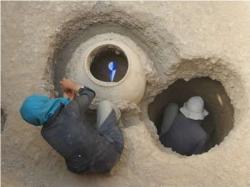 Firouzeh - A ceramic container with no stand which has been discovered in excavation operations in Firouzeh Township of Neyshabour region indicated that Iranians used second-hand containers some 4,500 years ago. Commenting on the findings of the five-year archeological excavations, Head of the archeological team Hassan Basafa said the operations were focused on various burial methods in the southern part of the cemetery which had been unearthed in previous excavations.He said the cemetery was the most important discovery in Firouzeh Township whereby valuable information was collected on ideological and ritual practices of people of Neyshabour in 4,500 years ago.He pointed to various graves discovered in the cemetery such as no-tomb graves, pit graves, crock burial and secondary burial, adding that in one of the no-tomb graves two ceramic containers, one with no stand was discovered together with a big piece of coal.The no-stand container was indicative of the tradition of using second-hand containers at that time examples of which are available in Central Asia as well.According to Basafa, Firoueh Township is an important historical site of Bronze Age in Neyshabour and northeast of Iran which dates back to 2500 years before Christ (about 4,500 years ago).The archeologist noted that Firouzeh Township used to be an industrial and administrative center at its time and with regard to the pottery baking furnaces, seals and tools discovered people of the township are expected to be specialists who traded with their neighborhood.The historical site in Firouzeh Township, 5 km from northeast of the historical city of Neyshabour, was discovered during construction operations for housing units and currently archeologists are involved in research operations there.
Firouzeh - A ceramic container with no stand which has been discovered in excavation operations in Firouzeh Township of Neyshabour region indicated that Iranians used second-hand containers some 4,500 years ago. Commenting on the findings of the five-year archeological excavations, Head of the archeological team Hassan Basafa said the operations were focused on various burial methods in the southern part of the cemetery which had been unearthed in previous excavations.He said the cemetery was the most important discovery in Firouzeh Township whereby valuable information was collected on ideological and ritual practices of people of Neyshabour in 4,500 years ago.He pointed to various graves discovered in the cemetery such as no-tomb graves, pit graves, crock burial and secondary burial, adding that in one of the no-tomb graves two ceramic containers, one with no stand was discovered together with a big piece of coal.The no-stand container was indicative of the tradition of using second-hand containers at that time examples of which are available in Central Asia as well.According to Basafa, Firoueh Township is an important historical site of Bronze Age in Neyshabour and northeast of Iran which dates back to 2500 years before Christ (about 4,500 years ago).The archeologist noted that Firouzeh Township used to be an industrial and administrative center at its time and with regard to the pottery baking furnaces, seals and tools discovered people of the township are expected to be specialists who traded with their neighborhood.The historical site in Firouzeh Township, 5 km from northeast of the historical city of Neyshabour, was discovered during construction operations for housing units and currently archeologists are involved in research operations there.
http://www.irna.ir/en/News/81597897/?
CHINE – 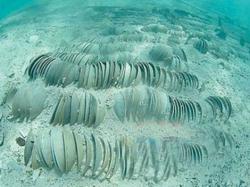 Xisha - A team of Chinese archaeologists embarked on one of the country's largest underwater surveys in mid-April, in the Xisha Islands in the South China Sea. The 25 underwater archaeologists are equipped with a 900-ton archaeological vessel and four auxiliary vessels. The survey is focused on Yongle Atoll, which is located to the west of Xisha Islands. And the crew has found a substantial amount of stone building material and carvings at the site.These artifacts contain a wealth of historical information and valuable proof of the ancient Maritime Silk Route. This was a maritime route that connected China with other regions of the world for trade and cultural exchanges. "The platform is right above the historical site. There are a large amount of stone building materials, which were of different usages. And we also found some pieces of porcelain in this area," said Deng Qijiang, the crew member. This is the second notable underwater archaeological excavation in the South China Sea following the Huaguang reef shipwreck found in 2008, where a vessel loaded with porcelain sank more than 700 years ago. The site is also in the Xisha Islands. China has discovered more than 120 shipwrecks in the South China Sea.
Xisha - A team of Chinese archaeologists embarked on one of the country's largest underwater surveys in mid-April, in the Xisha Islands in the South China Sea. The 25 underwater archaeologists are equipped with a 900-ton archaeological vessel and four auxiliary vessels. The survey is focused on Yongle Atoll, which is located to the west of Xisha Islands. And the crew has found a substantial amount of stone building material and carvings at the site.These artifacts contain a wealth of historical information and valuable proof of the ancient Maritime Silk Route. This was a maritime route that connected China with other regions of the world for trade and cultural exchanges. "The platform is right above the historical site. There are a large amount of stone building materials, which were of different usages. And we also found some pieces of porcelain in this area," said Deng Qijiang, the crew member. This is the second notable underwater archaeological excavation in the South China Sea following the Huaguang reef shipwreck found in 2008, where a vessel loaded with porcelain sank more than 700 years ago. The site is also in the Xisha Islands. China has discovered more than 120 shipwrecks in the South China Sea.
http://english.cntv.cn/2015/05/06/VIDE1430844240931223.shtml?
ITALIE – 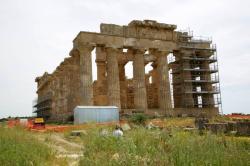 Selinonte - Temples are 'caged' against the ravages of time by scaffolding in the 270-hectare Selinunte archaeological park near Trapani. The caves of Cusa are in the other 40 hectares.Restoration work that began in May last year is supposed to be completed between June and July. The city was founded by Megara Hyblaea residents in Sicily in the seventh century BC near two port-canals, now sanded over, and engaged in intense maritime trade.''It was due to this expert use of the geographical role of Selinunte,'' historians say, ''that their inhabitants, in the space of just over two centuries, achieved an economic prosperity unrivaled in the Greek world or in that of Sicily/Magna Grecia.'' A city of grandiose size was built with numerous places of worship and public works of high quality. Due to conflict between the Greeks and the Punics in the late fifth century BC, it lost its urban splendor, becoming an important Punic center of trade. Here the Greeks built four parallel temples close to each other in the southern zone for worship and other public activities. ''The position of the acropolis was extremely privileged due to its extension,'' archaeologists say,'' towards the sea, between the western and eastern coves. Its elevation over the sea was balanced and enabled easy monitoring of the two ports to it, linked by short and easy access.'' Selinunte construction materials were excavated from the Cusa caves. They were in use from the sixth century BC until the defeat of the Greeks by the Carthaginians in 409 BC.
Selinonte - Temples are 'caged' against the ravages of time by scaffolding in the 270-hectare Selinunte archaeological park near Trapani. The caves of Cusa are in the other 40 hectares.Restoration work that began in May last year is supposed to be completed between June and July. The city was founded by Megara Hyblaea residents in Sicily in the seventh century BC near two port-canals, now sanded over, and engaged in intense maritime trade.''It was due to this expert use of the geographical role of Selinunte,'' historians say, ''that their inhabitants, in the space of just over two centuries, achieved an economic prosperity unrivaled in the Greek world or in that of Sicily/Magna Grecia.'' A city of grandiose size was built with numerous places of worship and public works of high quality. Due to conflict between the Greeks and the Punics in the late fifth century BC, it lost its urban splendor, becoming an important Punic center of trade. Here the Greeks built four parallel temples close to each other in the southern zone for worship and other public activities. ''The position of the acropolis was extremely privileged due to its extension,'' archaeologists say,'' towards the sea, between the western and eastern coves. Its elevation over the sea was balanced and enabled easy monitoring of the two ports to it, linked by short and easy access.'' Selinunte construction materials were excavated from the Cusa caves. They were in use from the sixth century BC until the defeat of the Greeks by the Carthaginians in 409 BC.
http://www.ansamed.info/ansamed/en/news/sections/generalnews/2015/05/06/archaeology-temples-caged-against-time-in-selinunte_f2787f25-bb08-44d0-8b7d-55f99826c67a.html?idPhoto=1
CHINE – 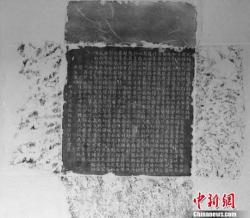 Xi'an - Chinese archaeologists claimed to have discovered an ancient tomb belonging to a high-profile doctor who lived more than 700 years ago in the northwest of the country. The newly-discovered tomb, located at a village of Xi'an City, capital of the Shaanxi province, dates back to the Yuan dynasty (1271-1368), said Duan Yi, associate professor with Shaanxi Provincial Institute of Archaeology. A gravestone inscribed with 665 words inside the tomb revealed the identity of its owner, Wu Jing. Wu was born into the famous Ru Yi (Confucian doctor) family in Zhouzhi, now a county of Xi'an. Confucian doctors were a special group proficient in both Confucianism and medicine, which allowed them a high status during that period. Wu was appointed to a post in charge of local medical services and education, similar to today's head of a medical school, the inscription on the gravestone said. A story was recorded in the gravestone that he once cut flesh from his own arm to feed his ailing mother to show filial piety. "The tomb is an important discovery that will shed light on unknown aspects of medical history and social culture in the Yuan dynasty," said Duan. The tomb is composed of a passage, a door and a burial chamber. Old iron nails, rotten wood ashes and unknown bone residue were found in the chamber, state-run Xinhua quoted him as saying. A total of 76 burial objects including pottery and jade were also discovered in the tomb.
Xi'an - Chinese archaeologists claimed to have discovered an ancient tomb belonging to a high-profile doctor who lived more than 700 years ago in the northwest of the country. The newly-discovered tomb, located at a village of Xi'an City, capital of the Shaanxi province, dates back to the Yuan dynasty (1271-1368), said Duan Yi, associate professor with Shaanxi Provincial Institute of Archaeology. A gravestone inscribed with 665 words inside the tomb revealed the identity of its owner, Wu Jing. Wu was born into the famous Ru Yi (Confucian doctor) family in Zhouzhi, now a county of Xi'an. Confucian doctors were a special group proficient in both Confucianism and medicine, which allowed them a high status during that period. Wu was appointed to a post in charge of local medical services and education, similar to today's head of a medical school, the inscription on the gravestone said. A story was recorded in the gravestone that he once cut flesh from his own arm to feed his ailing mother to show filial piety. "The tomb is an important discovery that will shed light on unknown aspects of medical history and social culture in the Yuan dynasty," said Duan. The tomb is composed of a passage, a door and a burial chamber. Old iron nails, rotten wood ashes and unknown bone residue were found in the chamber, state-run Xinhua quoted him as saying. A total of 76 burial objects including pottery and jade were also discovered in the tomb.
http://www.business-standard.com/article/pti-stories/archaeologists-unearth-tomb-of-ancient-doctor-in-china-115050600712_1.html
ROYAUME UNI –  Gloucester - Starting tomorrow Border Archaeology Ltd will carry out an archaeological evaluation of the car park in Upper College Green to the South of the cathedral. The area being investigated served predominantly as a cemetery throughout the monastic period and remained open for burials until the early 19th century. To date no significant archaeological deposits have been found above a depth of approximately 600mm below existing ground level and this information has been supported by the results of a recent radar survey. This is the first major dig in the city centre since 150 Roman skeletons were found during an archaeological excavation at a site off Brunswick Road in Gloucester.
Gloucester - Starting tomorrow Border Archaeology Ltd will carry out an archaeological evaluation of the car park in Upper College Green to the South of the cathedral. The area being investigated served predominantly as a cemetery throughout the monastic period and remained open for burials until the early 19th century. To date no significant archaeological deposits have been found above a depth of approximately 600mm below existing ground level and this information has been supported by the results of a recent radar survey. This is the first major dig in the city centre since 150 Roman skeletons were found during an archaeological excavation at a site off Brunswick Road in Gloucester.
http://www.gloucestercitizen.co.uk/lies-beneath-Gloucester-Cathedral/story-26449233-detail/story.html#ixzz3ZNZNNK1r
TURQUIE – 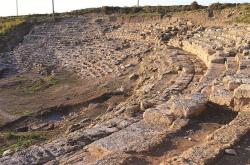 Magarsus - The theater of the ancient city of Magarsus, located in the southern province of Adana’s Karataş district, is getting ready to host culture and art events soon. Excavation work has been continuing in the ancient city for two years.
Magarsus - The theater of the ancient city of Magarsus, located in the southern province of Adana’s Karataş district, is getting ready to host culture and art events soon. Excavation work has been continuing in the ancient city for two years.
Magarsus dates back to the 5th century B.C. and its theater is 2,500 years old. The excavations have unearthed a large section of the theater, which is a typical Hellenistic-era theater. The sea-view ancient theater, which is 150 meters in length, 30 meters in width and has a capacity of some 3,000 people, will serve culture and art events when the work is completed and the theater will once again open its curtains after 2,500 years. Magarsus was the religious center of Mallus, which was one of the most important cities of the Cilicia civilization, famous for its ancient temples.
http://www.hurriyetdailynews.com/ancient-theater-of-magarsus-ready-to-open-curtains.aspx?pageID=238&nid=81981
EGYPTE – 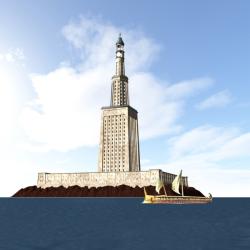 Alexandrie - The Lighthouse of Alexandria, one of the Seven Wonders of the Ancient World that was badly damaged by three earthquakes, will be rebuilt nearby its original location. The Lighthouse, also known as the Pharos, was badly damaged due to a series of earthquakes hit Alexandria and the Mediterranean area between the 3rd and 12th centuries, Greco-Roman archaeology professor Fathy Khourshid told The Cairo Post Tuesday. “A severe earthquake in 1303 caused a huge destruction of the monument before the Mamluk Sultan Qaitbay in 1480 reused the monument’s ruins to construct a fortress (currently standing and bearing his name) on the original location of the Pharos northwest of Alexandria,” according to Khourshid. Built by the Greek architect Sostratus of Cnidus for the purpose of guiding sailors into the harbor, the tower was completed and inaugurated during the reign of Ptolemy II Philadelphus (285 B.C.-246B.C.), said Khourshid. “The original building comprised three stages: a lower square section with a central core, a middle octagonal section and a circular section at its top,” he added. Its top used to have a mirror that reflected sunlight during the day while a fire was lit at night in order to guide ships, said Khourshid. In 1994, remains of the original building were unearthed on the floor of the sunken part of Alexandria’s eastern harbor. With a height estimated at 130 meters, (420 feet) the tower was the tallest manmade structure on Earth for many centuries.
Alexandrie - The Lighthouse of Alexandria, one of the Seven Wonders of the Ancient World that was badly damaged by three earthquakes, will be rebuilt nearby its original location. The Lighthouse, also known as the Pharos, was badly damaged due to a series of earthquakes hit Alexandria and the Mediterranean area between the 3rd and 12th centuries, Greco-Roman archaeology professor Fathy Khourshid told The Cairo Post Tuesday. “A severe earthquake in 1303 caused a huge destruction of the monument before the Mamluk Sultan Qaitbay in 1480 reused the monument’s ruins to construct a fortress (currently standing and bearing his name) on the original location of the Pharos northwest of Alexandria,” according to Khourshid. Built by the Greek architect Sostratus of Cnidus for the purpose of guiding sailors into the harbor, the tower was completed and inaugurated during the reign of Ptolemy II Philadelphus (285 B.C.-246B.C.), said Khourshid. “The original building comprised three stages: a lower square section with a central core, a middle octagonal section and a circular section at its top,” he added. Its top used to have a mirror that reflected sunlight during the day while a fire was lit at night in order to guide ships, said Khourshid. In 1994, remains of the original building were unearthed on the floor of the sunken part of Alexandria’s eastern harbor. With a height estimated at 130 meters, (420 feet) the tower was the tallest manmade structure on Earth for many centuries.
http://www.thecairopost.com/news/149009/culture/alexandria-lighthouse-to-be-reassembled-in-original-location
ISRAEL –  Khirbet Qumran - A 2,000-year-old copy of the Ten Commandments — the oldest known complete version — has gone on display for the first time in Israel. The scroll, which belongs to the Israel Antiquities Authority, is dated between the years 30 B.C. and 1 B.C. It was discovered along with the other Dead Sea Scrolls in the mid-20th century in Khirbet Qumran, an archaeological site near the shores of the Dead Sea that proved to hold a rich trove of ancient texts, including the oldest known versions of the Hebrew Bible.
Khirbet Qumran - A 2,000-year-old copy of the Ten Commandments — the oldest known complete version — has gone on display for the first time in Israel. The scroll, which belongs to the Israel Antiquities Authority, is dated between the years 30 B.C. and 1 B.C. It was discovered along with the other Dead Sea Scrolls in the mid-20th century in Khirbet Qumran, an archaeological site near the shores of the Dead Sea that proved to hold a rich trove of ancient texts, including the oldest known versions of the Hebrew Bible.
http://artsbeat.blogs.nytimes.com/2015/05/06/ancient-copy-of-ten-commandments-has-first-showing-in-israel/?